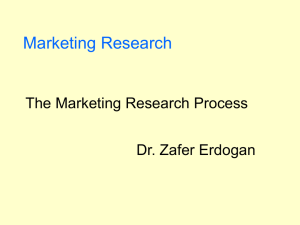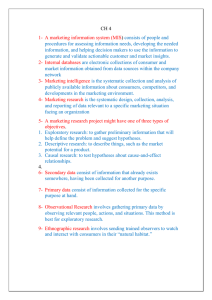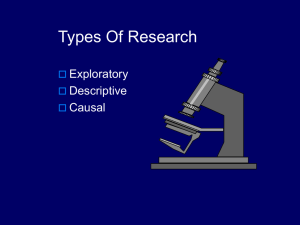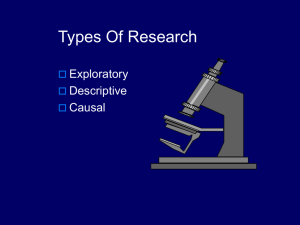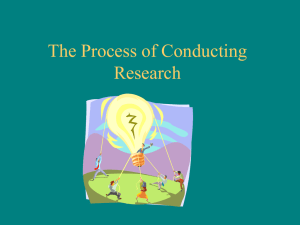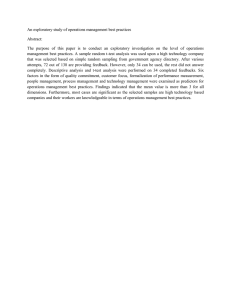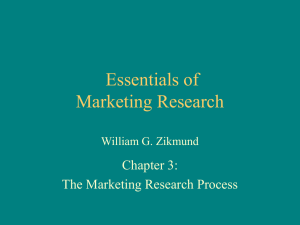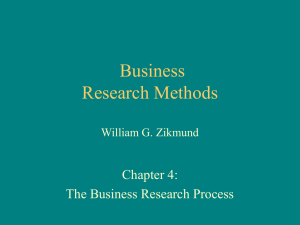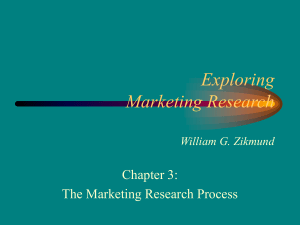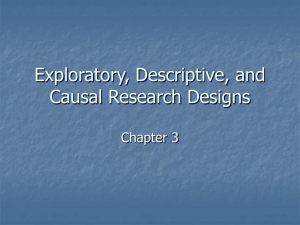Information • Reduces uncertainty • Helps focus decision making
advertisement
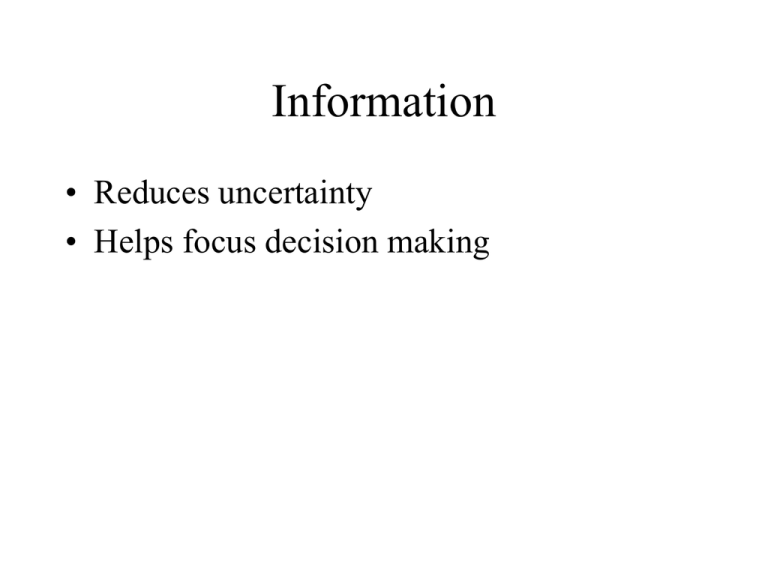
Information • Reduces uncertainty • Helps focus decision making Types Of Research • Exploratory • Descriptive • Causal Uncertainty Influences The Type Of Research CAUSAL OR DESCRIPTIVE COMPLETELY CERTAIN ABSOLUTE AMBIGUITY EXPLORATORY Degree of Problem Definition Exploratory Research (Unaware of Problem) “Our sales are declining and we don’t know why.” “Would people be interested in our new product idea?” Descriptive Research (Aware of Problem) Causal Research (Problem Clearly Defined) “What kind of people are buying “Will buyers purchase more of our product? Who buys our our products in a new package? competitor’s product?” “Which of two advertising “What features do buyers prefer campaigns is more effective?” in our product?” Exploratory Research Secondary data Experience survey Pilot studies Exploratory Research • Initial research conducted to clarify and define the nature of a problem • Does not provide conclusive evidence • Subsequent research expected Descriptive Research • Describes characteristics of a population or phenomenon • Some understanding of the nature of the problem I keep six honest serving men, (they taught me all I knew), their names are what, and why, and when, and how, and where and who.” --Rudyard Kipling Descriptive Research Example • • • • • Weight Watchers average customer Woman about 40 years old Household income of about $50,000 At least some college education Trying to juggle children and a job Descriptive Research Example • • • • Men’s fragrance market 1/3 size of women’s fragrance market But growing at a faster pace Women buy 80 % of men’s fragrances Causal Research • Conducted to identify cause and effect relationships Identifying Causality • A causal relationship is impossible to prove. • Evidence of causality: – 1. The appropriate causal order of events – 2. Concomitant variation--two phenomena vary together – 3. An absence of alternative plausible explanations Stages of the Research Process Discovery and Definition Problem Discovery and Definition Research Design and so on Conclusions and Report Sampling Data Processing and Analysis Data Gathering Research Stages • Cyclical process - conclusions generate new ideas • Stages can overlap chronologically • Stages are functionally interrelated – Forward linkages – Backward linkages Problem discovery Problem Discovery and Definition Sampling Selection of exploratory research technique Secondary (historical) data Experience survey Probability Pilot study Case study Data Gathering Data Processing and Analysis Problem definition (statement of research objectives) Experiment Laboratory Conclusions and Report Survey Field Interview Nonprobability Collection of data (fieldwork) Editing and coding data Data processing Selection of basic research method Research Design Selection of exploratory research technique Questionnaire Observation Secondary Data Study Interpretation of findings Report The Business Research Process Problem Discovery Selection of Sample Design Exploratory Research Collection of the Data Selection of the Basic Research Method The Research Process (cont.) Editing and Coding Data Processing Interpretation of the Findings Report Stages In The Research Process • • • • • • Problem Discovery and Problem Definition Research Design Sampling Data Gathering Data Processing and Analysis Conclusions And Report Problem Discovery And Definition • • • • First step Problem, opportunity, or monitor operations Discovery before definition Problem means management problem “The formulation of the problem is often more essential than its solution” Albert Einstein State the research questions and research objectives If you do not know where you are going, any road will take you there. Secondary (historical) Data Experience Survey Pilot Study Exploratory Research Case Study Exploratory Research Techniques Two Examples • Secondary data (historical data) – Previously collected – Census of population – Literature survey • Pilot study – A number of diverse techniques Focus Group Interview Research Design • Master plan • Framework for action • Specifies methods and procedures Basic Research Methods • • • • Surveys Experiments Secondary data Observation Selecting a Sample Sample: subset of a larger population. SAMPLE POPULATION Sampling • Who is to be sampled? • How large a sample? • How will sample units be selected? Data Gathering Stage Data Processing and Analysis Conclusions And Report Writing • Effective communication of the research findings Research Proposal • A written statement of the research design that includes a statement explaining the purpose of the study. • Detailed outline of procedures associated with a particular methodology Research Program Strategy Defining Problem Results in Clear Cut Research Objectives Symptom Detection Analysis of the Situation Problem Definition Statement of Research Objectives Exploratory Research (Optional)
